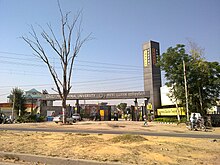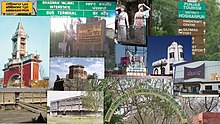
| Part of a series on |
| Punjabis |
|---|
 |
| History |
|
DiasporaAsia
Europe North America Oceania |
| Culture |
| Regions |
 Punjab portal |










Doaba, also known as Bist Doab or the Jalandhar Doab, is the region of Punjab, India that lies between the Beas River and the Sutlej River. People of this region are given the demonym "Doabia". The dialect of Punjabi spoken in Doaba is called "Doabi". The term "Doaba" or "Doab" is derived from Persian دو آب (do āb "two water") meaning "land of two rivers". The river Sutlej separates Doaba from the Malwa region to its south and the river Beas separates Doaba from the Majha region to its north.
Scheduled castes form more than 40% of the population in Doaba. This area is also called the NRI Hub of Punjab as a consequence of the migration of a significant percentage of Doabias.
Districts of Doaba
Doaba comprises the following districts:
Sub-divisions
Manjki
Manjki includes a large part of Nakodar tehsil, western parts of Goraya sub tehsil, Noormahal sub tehsil and western parts of Phillaur tehsil. The villages of Jandiala Manjki, and Bundala lie in Manjki. The south east of Phagwara also falls within Manjki.
It is not clear if the area takes its name from the Manj tribe which once held the track around Nakodar or the name is related to the condition of the land. The Manj Rajputs held a large tract in the south west of Jallandhar district stretching between Talwan, Nakodar and Malsian (to the west of Nakodar city).
The Arains were mainly settled in Phagwara, Nakodar, Kotla Nihang, Daulatpur and Noorpur. They were landholders of big agricultural tracts in the region. After partition almost all Arain population migrated from Jalandhar to Faisalabad (formerly Lyallpur), Bahawalpur, Rawalpindi and Lahore districts of Pakistan.
Hinduism and Sikhism are the main religions of the region. Before partition, the area had a sizeable Muslim majority, which led the Muslim League to hope that the Jalandhar division would be allotted to Pakistan. The majority of Muslims of this area after partition moved to the Faisalabad (formerly Lyallpur) district of Pakistan, and a small minority opted instead for the urban centers of Lahore and Rawalpindi. Some Sikhs and Hindus from the Lyallpur district were relocated in the Doaba region, especially in Manjki.
Dhak
The area known as Dhak includes the eastern part of Phillaur tehsil and Nawanshahr district. The Grand Trunk road separates the Dhak area from the Manjki area. The middle part of Phagwara tehsil is in Dhak.
Phagwara tehsil includes the Dhak area. The type of soil has traditionally been midway between clay loan or loamy clay and therefore the traditional main crop rotations were maize-wheat, paddy-wheat, sugarcane-wheat, and fodder-wheat, cotton-wheat.
Dona
The word 'Dona' means that the soil is formed of two constituents, sand and clay, with sand predominating. The area to the south of the river Beas falls within Dona. This area is formed by a part of the Kapurthala district.
Due to the type of soil in Dona, the main crop rotations traditionally being followed were: groundnut-wheat, groundnut-fallow, maize-wheat, cotton-wheat, and fodder-wheat.
Bet
The portion of Doaba that lies in the area between the river tract falling between the Beas and Black Bein is called "Bet".
The soil in Bet is clay loam or loamy or clay, and therefore the main crop rotations traditionally being followed were: paddy-wheat, maize-wheat, fodder-wheat, and toria-wheat.
Sirowal
The north eastern part of Phagwara tehsil lies in the Sirowal (also called Sirwal) region. Bhogpur and Adampur Blocks of Jalandhar district also lie in Sirowal.
Sirowal is characteristic of the Bet area with numerous hill streams coming down from Hoshiarpur district keeping the soil moist year round. Some of these streams are silt laden and at first deposit fertile soil though their later deposits are more and more sandy. Due to the existence of these drainage channels patches and stratas of hard clay are also to be found.
Places
Dasuya
Main article: DasuyaThe town is referred to in the ancient Indian epic, the Mahabharata, as the seat of king Virata. In recognition of this, Dasuya is still referred to as Virat Ki Nagri today.
See also
References
- Singh, Harbans. The Encyclopedia of Sikhism. Vol. 4: S-Z. Punjabi University, Patiala. p. 397.
- ^ Grover, Parminder Singh; Singh, Davinderjit (2011). "Section 1: Introduction – Regions of Punjab". Discover Punjab: Attractions of Punjab. Photographs by Bhupinder Singh. Ludhiana, Punjab, India: Golden Point Pvt Lmt.
Regions of Punjab: The much-truncated India's portion of present Punjab is divided into three natural regions: The Maiha, The Doaba, The Malwa. Majha: Majha starts northward from the right bank of river Beas and stretches up to the Wagha village, which marks the boundary between India and Pakistan. Majha in Punjabi means the heartland. The region is divided into three districts: 1. Amritsar, 2. Gurdaspur, 3. Tarn Taran. Doaba: The rivers Sutlei in the south and Beas in the North bound the Doaba of Puniab. The Doaba region is divided into four districts: 1. Jalandhar, 2. Nawanshahr, 3. Kapurthala, 4. Hoshiarpur. Malwa: The area south of the river Sutlej is called Malwa. The name has stuck because a clan called Molois (sometimes written as Malawis in ancient works) once ruled this area, which must have spread up to present State of Gujrat which was known as the Subah of Malwa as late as the Mughul times. Malwa the largest part of the Punjab is divided into the following 12 districts after the names of their headquarters: 1. Bathinda, 2. Barnala, 3. Faridkot, 4. Fatehgarh Sahib, 5. Ferozepur, 6. Ludhiana, 7. Mansa, 8. Moga, 9. Sangrur, 10. Muktsar, 11. Patiala, 12. Rup Nagar, 13. SAS Nagar - Mohali.
- "GAZETTEER OF INDIA". Archived from the original on 4 March 2016. Retrieved 3 April 2014.
- Gurharpal Singh; Darsham Singh Tatla (2006). Sikhs in Britain: The Making of a Community. London: Zed Books Ltd. p. 40. ISBN 978-1-84277-717-6.
big villages doaba.
- "Nawanshahr", Misplaced Pages, 8 November 2024, retrieved 9 November 2024
- ^ Rose, Horace Arthur, ed. (1911). A Glossary of the Tribes and Castes of the Punjab and North-West Frontier Province Volume 1 (1997 ed.). Nirmal Publishers and Distributors. p. 51. ISBN 9788185297682.
- ^ "History of Jalandhar" (PDF). Jalandhar Online. Archived from the original (PDF) on 30 October 2013. Retrieved 13 May 2017.
- "Full text of "Panjab castes"". archive.org. Retrieved 26 September 2019.
- "Demography of the Punjab (1849-1947)" (PDF). Archived from the original (PDF) on 24 September 2015. Retrieved 8 July 2014.
- Noorani, A.G. (25 February 2012). "Horrors of Partition". Frontline. Vol. 29, no. 4. Archived from the original on 7 March 2013.
- "Pak residents still approach MC for birth certificates". The Times of India. 11 August 2001. Archived from the original on 26 April 2013.
- "Remembering Partition, One Story at a Time". thelangarhall.com. 6 December 2011.
- ^ "Normal Soils of the Flat Plains and Old Flood Plains". Archived from the original on 1 August 2017. Retrieved 3 April 2014.
- Sharma, Baldev Raj, ed. (1979). "Punjab Gazetteer: Hoshiarpur". Archived from the original on 4 February 2012. Retrieved 21 February 2012.
| State of Punjab, India | ||
|---|---|---|
| Capital: Chandigarh | ||
| Topics |  | |
| Administration | ||
| Culture |
| |
| Divisions |
| |
| Districts | ||
| Major cities | ||
| Geography of South Asia | |||||||||
|---|---|---|---|---|---|---|---|---|---|
| Mountains |
| ||||||||
| Plateaus |
| ||||||||
| Deserts | |||||||||
| Lowlands |
| ||||||||
| Water-bodies |
| ||||||||
| Islands | |||||||||
| By country | |||||||||
| By region | |||||||||
| Historical regions of North India | |
|---|---|
31°20′N 76°10′E / 31.333°N 76.167°E / 31.333; 76.167
Categories: